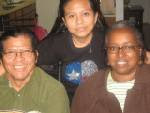
Introduction—I received my first graduation present. My school librarian and I eat lunch together and she gave me a wonderful picture book, “All God’s Critters” by Bill Staines. It’s colorful, humorous, and easy to read. I’ve already read it at storytime and the children started clapping and repeating the chorus without any prompting. It’s a fun book. Here’s the chorus.
“All God’s critters got a place in the choir,
Some sing low, some sing higher,
Some sing out loud on the telephone wire,
And some just clap their hands, or paws, or anything they got. Now……”
Staines, Bill. “All God’s Critters.” Nelson, Kadir, ill. New York: Simon & Schuster, 2009.
Extension—My granddaughter started clapping her hands on the beat and I was amazed how she connected the word clap and her to respond so quickly. She started the other children clapping and singing the chorus. A great book for the children who are visually inspired is “Doodle Dandies” by J. Patrick Lewis. The poems take on the shape of the subject of the poem. Look at the giraffe (pages are not numbered). It looks like a giraffe in words. It’s a cool book. Read, sing, and talk poetry out loud!
Lewis, J. Patrick. “Doodle Dandies: poems that take shape.” Desimini, Lisa, ill. New York: Atheneum Books for Young Readers, 1998.
A fun Book
“Poems go Clang: a collection of Noisy Verse.” Gliori, Debi, ill. 1997, Cambridge: Candlewick Press, 1997.
Conclusion—I have taken on a whole new world of appreciation for poetry and I will continue to enjoy poetry read out loud for years to come. I am still an immature poet, “Immature Poets imitate, mature poets steal,” T.S. Eliot. With time and practice, I hope to mature. Thank you Dr. Vardell for a wonderful course in “Poetry for Children and Young Adults.”







